
The genus Pritchardia consists of between 24 and 40 species of fan palms found on tropical Pacific Ocean islands in Fiji, Samoa, Tonga, Tuamotus, and most diversely in Hawaii. The generic name honors William Thomas Pritchard (1829-1907), a British consul at Fiji.

Livistona is a genus of palms, the botanical family Arecaceae, native to southeastern and eastern Asia, Australasia, and the Horn of Africa. They are fan palms, the leaves with an armed petiole terminating in a rounded, costapalmate fan of numerous leaflets.

Mitiaro, the fourth island in the Cook Islands group, is of volcanic origin. Standing in water 14,750 feet (4,500 m) deep it is four miles (6.4 km) across at its widest point.

Pritchardia remota, the Nihoa pritchardia, Nihoa fan palm, or Loulu, is a species of palm endemic on the island of Nihoa, Hawaiʻi, and later transplanted to the island of Laysan. It is a smaller tree than most other species of Pritchardia, typically reaching only 4–5 metres (13–16 ft) tall and with a trunk diameter of 15 centimetres (5.9 in). It is the only type of tree on the island and used to be abundant. In 1885 a wildfire ravaged the island, destroying most of the palms. Only about 700 of these trees remain, making the species endangered but numbers are slowly increasing. The palm is being cultivated in botanical gardens.
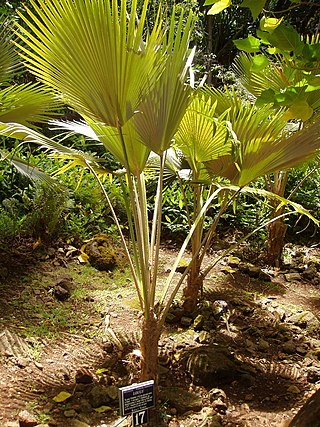
Pritchardia limahuliensis, the Limahuli Valley pritchardia, is a palm native to Hawaii. It is a rare species, only discovered in 1977 by staff of the National Tropical Botanical Garden in the Limahuli Garden and Preserve, Kauai, Hawaii, where it is now being conserved. It is threatened by introduced rats, which eat the seeds.

Zombia antillarum, commonly known as the zombie palm, is a species of palm tree and the only member of the genus Zombia. It is endemic to the island of Hispaniola in the Greater Antilles. Usually found in dry, hilly areas of northern and southern Haiti and the northwest of the Dominican Republic, Z. antillarum is a relatively short fan palm with clustered stems and a very distinctive appearance caused by its persistent spiny leaf sheaths. Threatened by habitat destruction in Haiti, Z. antillarum is a popular ornamental species due to its distinctive appearance, low maintenance requirements and salt tolerance.
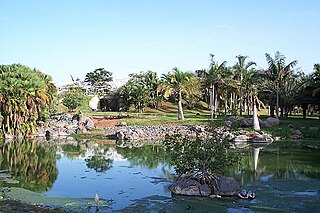
The Palmetum of Santa Cruz de Tenerife is a botanical garden of 120.000 m² specialized in palms (Arecaceae). It is an artificial hill, with views of the ocean, located in Santa Cruz de Tenerife, Canary Islands, Spain. The gardens include a large system of waterfalls, streams and ponds, a museum dedicated to palms, and a display shade house. The project was started in 1995 on a former landfill and only opened to the public in 2014. The valuable palm collection gathers about 600 species of palms and it is focused on the ones native to world islands. Trees and shrubs of other plant families are also displayed, organised in "biogeographical sections". All gardens are maintained with no pesticides and no fertilizers, different species of wild birds are easily seen in the palmetum.

Pritchardia lowreyana, the Molokai pritchardia, is a species of fan palm that is endemic to Hawaii in the United States. It is found in mixed mesic and wet forests on the island of Molokaʻi. P. lowreyana reaches a height of 2–4 m (6.6–13.1 ft), and normally grows in gulches and on cliffs. It was named in 1918 for Cherilla Storrs Lowrey (1861–1918), an American clubwoman active in tree-planting and beautification projects around Honolulu.
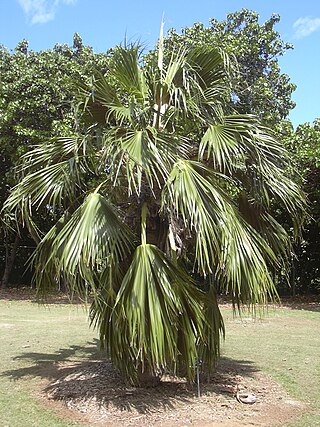
Pritchardia munroi, the Kamalo pritchardia, is a species of fan palm that is endemic to Hawaii in the United States. It is found in dry forests on the eastern (leeward) side of the island of Molokaʻi. The specific epithet, refers to James Monro, the manager of the Molokai Ranch at the time of its discovery (1920). Only two individuals exist in the wild, and both are at an elevation of 610 m (2,000 ft). It reaches a height of 4–5 m (13–16 ft) and a trunk diameter of 20 cm (7.9 in).
Pritchardia perlmanii, the Waiʻoli Valley pritchardia, is a species of palm tree that is endemic to the island of Kauaʻi in Hawaii, United States. It inhabits lowland mesic forests in the Waiʻoli Valley at an elevation of 420–850 m (1,380–2,790 ft). P. perlmanii reaches a height of 10 m (33 ft) and a trunk diameter of 30 cm (12 in).
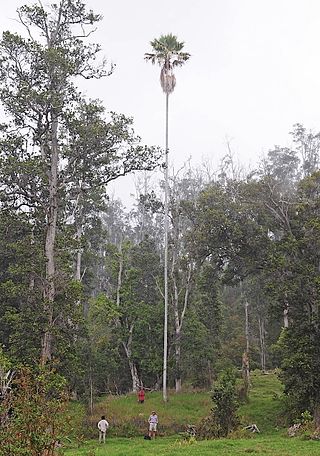
Pritchardia schattaueri, the lands of papa pritchardia or Schattauer's loulu, is a species of palm tree in the genus Pritchardia that is endemic to mixed mesic forests on the southwestern part of island of Hawaiʻi, near Kona. It is officially listed as a Critically endangered species.
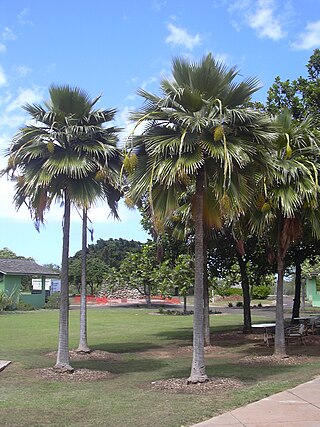
Pritchardia thurstonii is a species of flowering plant in the family Arecaceae. It is endemic to Fiji, in particular the Lau Islands. It is threatened by habitat loss.
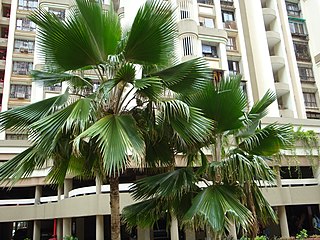
Pritchardia pacifica, the Fiji fan palm, is a species of palm tree in the genus Pritchardia that is native to Tonga. It is also found on Fiji, Samoa, and the Marquesas however these populations are likely to be human introductions.
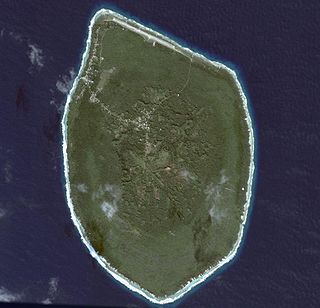
Mauke is an island of the Cook Islands archipelago, lying in the central-southern Pacific Ocean. Part of the Nga-pu-Toru, it is 277 km (172 mi) northeast of Rarotonga.

Steven "Steve" Perlman is a botanist known for his work at the National Tropical Botanical Garden in Hawaii.

Pritchardia beccariana, the Kilauea pritchardia, or Beccari's loulu, is a species of palm tree in the genus Pritchardia that is endemic to wet forests on the eastern part of the island of Hawaiʻi, near Hilo.

Geniostoma sykesii is a species of flowering plant in the family Loganiaceae, endemic to the islands of Mangaia and Mitiaro in the Cook Islands. It grows on makatea terrain. Its dried leaves are used in ‘ei, and used to scent multiple products.
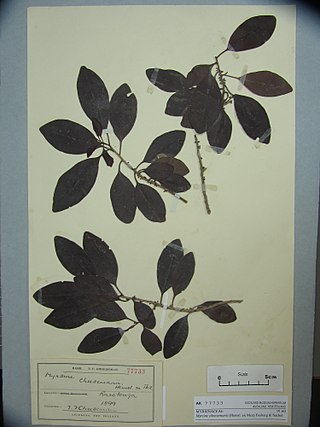
Myrsine cheesemanii, known as the Cook Islands myrsine or ka‘ika makatea, is a species of shrub within the family Myrsinaceae. It is endemic to the Cook Islands, growing on the islands of Rarotonga, Mangaia, Mauke and Mitiaro.
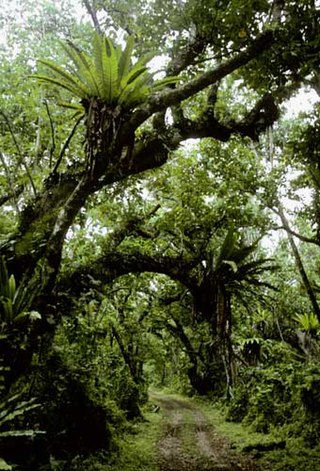
The Cook Islands tropical moist forests is a tropical and subtropical moist broadleaf forests ecoregion that covers the Southern Cook Islands in the Cook Islands.

The Tuamotu tropical moist forests is a tropical and subtropical moist broadleaf forests ecoregion in the Tuamotu Archipelago of French Polynesia and the Pitcairn Islands.



















